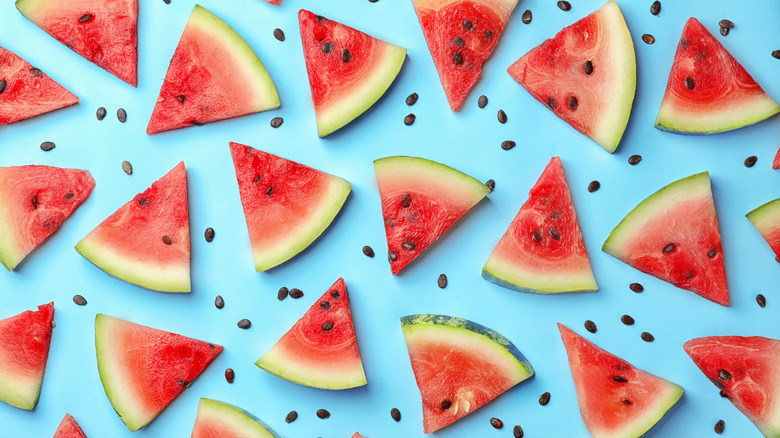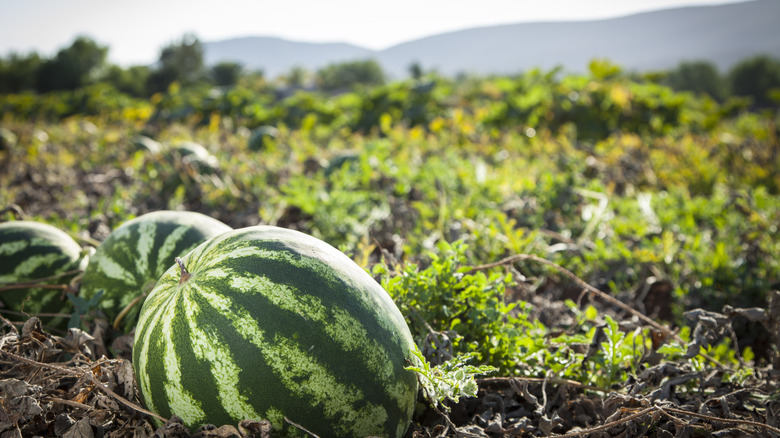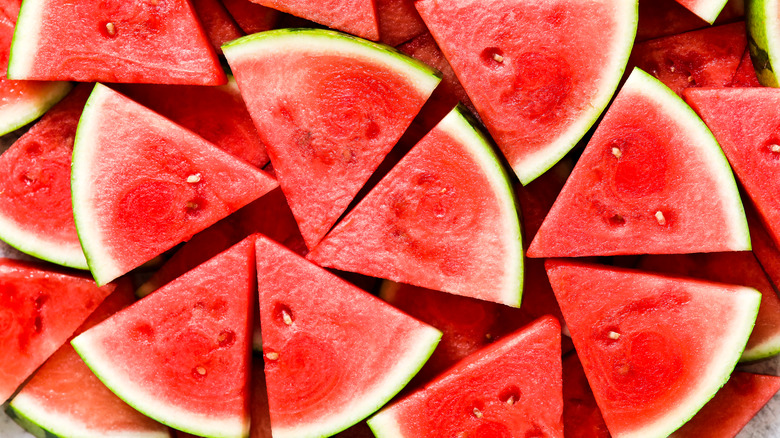Seedless Watermelons Aren't Actually A Thing
Biting into a juicy watermelon and feeling your mouth flood with sweetness is great until the experience is rudely interrupted by the jarring crunch of a stray seed. Some take it all in stride, munching on the seeds or skillfully spitting them out like projectiles; and others search for a way to enjoy the watermelons sans seeds without spending thousands of dollars on the world's most expensive watermelon, which is virtually seedless.
Commercially grown seedless watermelons sound like they would solve this conundrum, but that's only partially the case. They may contain as many seeds as the regular variety; it's just that the kinds of seeds differ. Seedless watermelons are formulated so the seeds do not mature and turn into the black, crunchy pips we're all used to seeing. They do, however, retain the soft white precursors to fully matured seeds. The process involves crossbreeding, making growing seedless watermelons a relatively complex affair.
More complicated to grow than the regular kind, and without eliminating seeds completely, seedless watermelons are nonetheless very popular and account for up to 92% of watermelon sales in the country, according to the National Watermelon Promotion Board. So, why exactly are they considered seedless?
How are seedless watermelons grown?
Since all the seeds in a seedless watermelon are infertile, growing these fruits poses a bit of a complication. Seedless watermelons were conceived over 50 years ago in a paper by Professor H. Kihara from Japan titled "Triploid Watermelons," published in the Proceedings of the American Society for Horticultural Science in 1951. This eventually led to the formation of the American Seedless Watermelon Corporation and the development of several varieties of seedless watermelon. However, it still took quite a while for commercial production to get underway, which only began in the 1990s.
Seedless watermelons are also called triploids, and their seeds contain 33 chromosomes — the odd number of chromosomes makes the seeds infertile. A regular watermelon seed capable of growing into a plant contains 22 chromosomes and is called a diploid. Through a process called random mutagenesis, a diploid plant is mutated to develop 44 chromosomes, thereby becoming a tetraploid. When crossbred, diploids and tetraploids result in triploids, which are the seedless watermelon variety we know.
All this may sound a little complicated, but it essentially means that seedless watermelons are a hybrid of two watermelon varieties and non-GMO (not genetically modified). Since triploids require diploids and tetraploids to cross-pollinate, growers often plant seeded and seedless varieties side by side in the field.
Seedless watermelons have white seeds instead of black seeds
The seeds in a regular watermelon are black and slightly plump. These are fully mature, fertile seeds that, when planted, will grow into a watermelon plant. The seeds are crunchy, and though many find them annoying, can actually make for a healthy snack that's low in calories and rich in nutrients like zinc, magnesium, iron, and healthy fats. Leftover watermelon rinds, too, can be repurposed into surprisingly delicious fare, so next time pick out a clean one, and toss nothing out.
You'll occasionally find white seeds in watermelons. These are thinner, softer, and less intrusive to the eating experience since they are not crunchy. Such seeds are essentially underdeveloped or immature seeds that are not fertile. To make watermelons "seedless," they are crossbred so that all seeds remain immature. Therefore, a seedless watermelon can easily have as many seeds as a regular watermelon; it's just that those seeds will be the white, softer kind.
The fact that the seeds are smaller, softer, and easier to swallow with watermelon flesh sets seedless watermelons apart. The USDA makes no distinctions between the health benefits of seeded and seedless watermelons, and seeds from both are safe to consume. Therefore, choosing a watermelon all comes down to whether you want one with more crunchy black seeds or more soft white ones.


